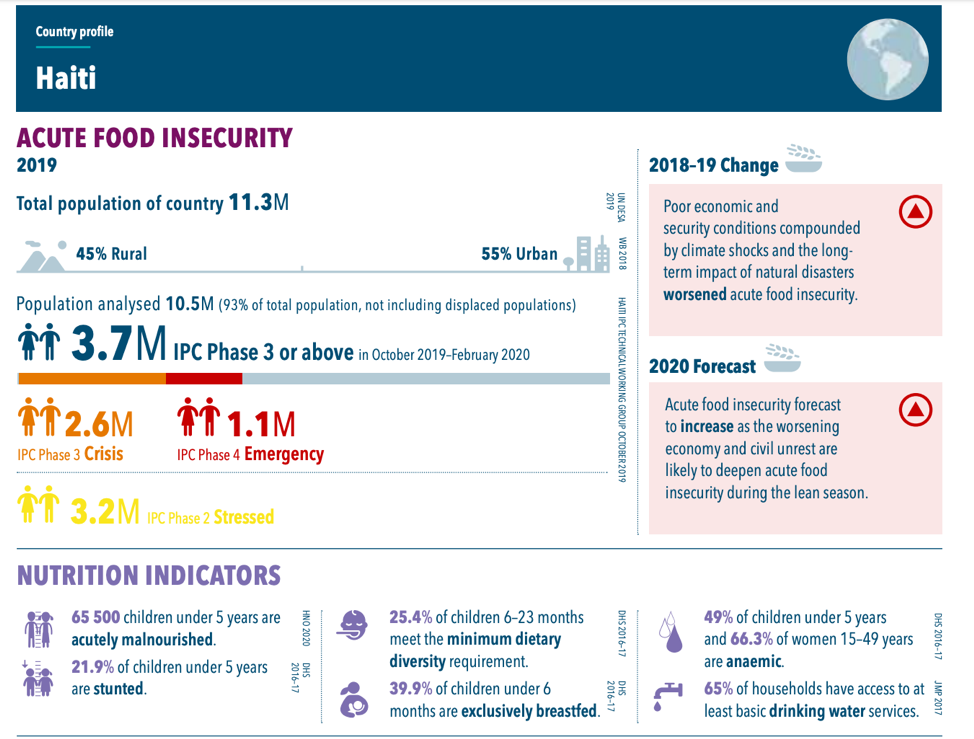 Covering COVID-19 is a daily Poynter briefing about journalism and coronavirus, written by senior faculty Al Tompkins. Sign up here to have it delivered to your inbox every weekday morning.
Covering COVID-19 is a daily Poynter briefing about journalism and coronavirus, written by senior faculty Al Tompkins. Sign up here to have it delivered to your inbox every weekday morning.
The next global emergency is at the door — a food crisis
I share this note first today not because it will be the easiest story for you to find a way to cover, but because it may well be the most important.
It seems that we humans are pretty good at responding to emergencies but not so great at anticipating them. This is a wolf at the door. A global food crisis, connected to the COVID-19 pandemic, is unfolding.
By the end of the year, experts say 265 million people may be hungry. This is not a running-out-of-toilet-paper kind of shortage. This is pleading-for-food hungry. This is dying-from-starvation hungry.
Read this passage from The New York Times:
Already, 135 million people had been facing acute food shortages, but now with the pandemic, 130 million more could go hungry in 2020, said Arif Husain, chief economist at the World Food Program, a United Nations agency. Altogether, an estimated 265 million people could be pushed to the brink of starvation by year’s end.
This emerging crisis is unlike regional problems caused by political or military strife. It is not local storm damage. It is a global emergency and it does not hit all of us equally. The poor lose more.
Extreme hunger will lead to protests, violence and political instability. It is already unfolding. World Food Program executive director David Beasley told the United Nations Security Council this week that COVID-19 — coupled with locust swarms in East Africa, wars in Syria and Yemen and interruptions in the normal food supply chains around the world — would add to an impending disaster.
“So today, with COVID-19, I want to stress that we are not only facing a global health pandemic but also a global humanitarian catastrophe,” Beasley said. “Millions of civilians living in conflict-scarred nations, including many women and children, face being pushed to the brink of starvation, with the specter of famine a very real and dangerous possibility.”
In this detailed World Food Program report, you can look at the situation and forecasts country-by-country around the world.
Let me focus just on one of our closest neighbors, as an example. The report says close to four million Haitians are in an emergency or crisis right now. The report predicts civil unrest because of the impending crisis. One in five Haitian children have stunted growth, half of young Haitian children and two-thirds of Haitian women are anemic.
The report shows extreme weather in Central America is causing severe food insecurity in Honduras and Guatemala.
Journalists, let’s not wait until August when world leaders will say they didn’t know about this crisis in the making.
The charities in your community that deal with global crises are a starting place for you. You can also help audiences find the best charities. Visit Guidestar and enter “world hunger” or “Haiti food” and the city or state you want to focus on to find a local charity doing work there. Before you tell audiences to spend their already strained resources on a charity, you should read the charity’s financial statements to see how much money goes to fundraising and administration and how much goes to delivering food.
To put a local face on the story, connect with immigrants who may have family abroad or with refugee resettlement groups that have contacts around the world.
Sometimes it is hard to try to focus on others when you are hurting, but it is not like we have a choice this time.
[the_ad id=”667826″]
Could states go bankrupt?
U.S. Senate Majority Leader Mitch McConnell told radio talk show host Hugh Hewitt Wednesday that states could go bankrupt.
I am including both the question and answer because the answer is mostly focused on something Hewitt has talked about a good bit — some state pension programs are way underfunded. McConnell said he does not want federal tax dollars to bail out badly run state pension programs:
Hewitt: I think people do not understand how badly mismanaged some states have been, and their unfunded liabilities. And if they were in the private sector, they would have to reorganize under the bankruptcy code. But there is no bankruptcy code chapter. Do you think that we need to invent one for states so that they can discharge some of these liabilities that were put in place by previous governors like, I mean, Jerry Brown ran a giveaway program for public employee unions that was just astonishing, and as did Gray Davis, as did, you know, a lot of Democratic governors, Illinois is probably the worst, and Connecticut. They’ve just given money away for years to people who aren’t working.
McConnell: Yeah, I would certainly be in favor of allowing states to use the bankruptcy route. It saves some cities. And there’s no good reason for it not to be available. My guess is their first choice would be for the federal government to borrow money from future generations to send it down to them now, so they don’t have to do that. That’s not something I’m going to be in favor of.
This is an opportunity for you to explore the pension crunch that will grow worse with the economic slowdown caused by the pandemic. Even before the pandemic, the states would have needed a trillion dollars to fund the pensions that have been promised to state workers. This is a story for all 50 states, and especially for those of you in and near state capitals, where so many of your audience members work for the government.
Pew has data for you. The Pew website says, “Pew has been tracking state-run pension system funding since 2007. This latest study covers data for state-run pension systems for fiscal year 2017, the most recent year for which comprehensive data were available for all 50 states. The 230 plans included in Pew’s data cover state employees, teachers, police officers, firefighters, university professors, and other state and local public employees.”
COVID-19’s strange blood-clotting complications
Over the last several days we have been seeing reports from physicians who are astonished that COVID-19 patients who have extremely low blood oxygen levels seem to be functioning just fine. There are stories of people who test positive, show no symptoms, then die quickly. And The Washington Post noted the strange stories of pregnant women who test positive for COVID-19 and go into cardiac arrest.
There is increasing evidence that this virus not only attacks the lungs, but also the kidneys and the heart.
And now, a new complication is arising. The Post reported:
One doctor replied that one of his patients had a strange blood problem. Despite receiving anticoagulants, the patient was still developing clots. A second said she’d seen something similar. And a third. Soon, every person on the text chat had reported the same thing.
“That’s when we knew we had a huge problem,” said Coopersmith, a critical-care surgeon. As he checked with his counterparts at other medical centers, he became increasingly alarmed: “It was in as many as 20, 30 or 40% of their patients.”
Medical experts said this clotting issue is one of the most talked-about new findings around COVID-19 right now. CNN reported:
“The number of clotting problems I’m seeing in the ICU, all related to COVID-19, is unprecedented,” Dr. Jeffrey Laurence, a hematologist at Weill Cornell Medicine in New York City, wrote in an email to CNN. “Blood clotting problems appear to be widespread in severe COVID-19.”
Laurence and his colleagues looked at autopsies on two patients and found blood clots in the lungs and just beneath the surface of the skin, according to a study published last week. They also found blood clots beneath the skin’s surface on three living patients.
In the Netherlands, a study found “remarkably high” rates of clotting among COVID-19 patients in the ICU.
[the_ad id=”667872″]
Pig farmers are in big trouble — another big processing plant closes
Another big meat processing plant closed Wednesday, this time the largest one run by Tyson. That one Iowa meat processing center handles 4% of the nation’s pork. It is yet one more problem for hog farmers who have increasingly fewer options to where to send their animals, even if somebody wanted to buy pork.
Pig farmers are killing newborn piglets because they have no room to raise them and no market to sell them if they did. The Associated Press reported that without COVID-19, this might have been the “comeback year” for pork producers. But, the AP said, “Instead, restaurant closures due to the coronavirus have contributed to an estimated $5 billion in losses for the industry, and almost overnight millions of hogs stacking up on farms now have little value.”
Last year, while the U.S. was still locked in a trade war with China and Mexico, pork sales plummeted. But with new trade agreements in place, there was a chance for a comeback.
Then came COVID-19. The first problem was restaurants closing. Then exports lagged, because COVID-19 is a global problem and consumers around the world are not buying as they usually do. Then an even bigger problem — pork processing plants, including the biggest one in the country, closed because workers there were getting sick.
Dermot Hayes, an economist with Iowa State University, and Steve Meyer, a pork industry economist with agricultural risk management firm Kerns & Associates, estimated that hog farmers will lose nearly $37 per hog, or almost $5 billion collectively for the rest of the year.
Pig farmers and dairy farmers are in a different pinch than, say, poultry or beef farmers. Pork is a “just-in-time” commodity. Meat processing plants do not store up a lot of product. They butcher, process and ship as fast as possible, from hoof to grocery stores. The AP explained why:
Whereas poultry producers can slow production by not hatching baby chicks and ranchers can keep cattle on pastures longer, pork farmers don’t have good options. Hogs are raised inside barns with limited space, and it takes time to stop the birthing cycle for pigs.
“We are in crisis and need immediate government intervention to sustain a farm sector essential to the nation’s food supply,” said Howard Roth, a pig farmer from Wauzeka, Wisconsin, and president of the National Pork Producers Council, an industry trade group.
Some pork producers said they are “hanging on for dear life,” and may not pull out of this crisis.
Journalists, here is a page full of resources you can turn to in order to make this story local. Many universities have agriculture departments that have expertise in this area. And this page also has a ton of links to specialized newsletters and resources to help you find your story.
Would out-of-work journalists be great contact tracers?
As I listened to an expert describe the work of “contact tracers” that government agencies around the country are hiring, it occurred to me that out-of-work journalists would be great for those jobs.
New York Gov. Andrew Cuomo described the job as “a detective, investigator, in the public health space.” By one estimate, the U.S. needs to hire 100,000 contact tracers. We currently have about 2,000 such workers in America, trying to control everything from syphilis to measles.
Massachusetts said it is hiring contact tracers and paying them $27 per hour and is also using volunteers to help.
Contact tracing is intensive work that starts with identifying a person who is COVID-19 positive, then interviewing that person to find out who they came in contact with and where they have been. The skill is well known in health circles in fighting tuberculosis and SARS. Countries in Southeast Asia, Africa and South America have used contact tracers effectively in fighting infectious diseases. Germany, Singapore and South Korea all used extensive contact tracing in the fight against COVID-19 and it helped them reopen their economies much faster.
Training may come pretty quickly. NBC New York reported:
The Bloomberg School of Public Health at Johns Hopkins University will build an online curriculum and training program for contact tracers. Meanwhile, the New York State Department of Health will work with Bloomberg Philanthropies to help identify and recruit contact tracer candidates for the training program.
Many of North Dakota’s newly enlisted 300 contact tracers are graduate students earning credit toward their masters in public health. The state is contacting health care workers who have been furloughed due to canceled office visits and elective surgeries, as well as tapping members of the National Guard, and is still looking for another 200 disease trackers.
Look at the job requirements from one recruiter trying to hire contact tracers. They sound a lot like what journalists do every hour of the day.
Responsibilities
- Call contacts of newly diagnosed patients.
- Communicate with contacts in a professional and empathetic manner.
- Collect and record information on symptoms into the CRM.
- Provide contacts with approved information about Massachusetts quarantine procedures, and if appropriate, refer them to testing according to protocol and/or to a COVID-19 Care Resource Coordinator for social resources.
- Contact tracers will follow the script to inform contacts about the importance of quarantine and what to do if symptoms develop. They are not permitted to deviate from the script or provide information that is not included in the script.
- Contact tracers will be required to use their own telephone, computer and electronic equipment.
- Maintain daily contact with supervisor.
Qualifications
- Ability to exhibit a professional, positive attitude and work ethic
- Excellent interpersonal skills required and ability to interact professionally with culturally diverse individuals during a time of crisis and distress
- Ability to show empathy to distressed individuals
- High school diploma, or equivalent required
- Excellent organizational and communication skills
- Ability to speak, read, and write English
- Second or multiple languages a plus
- Critical thinking and sound judgment required
- Ability to handle confidential information with discretion and professionalism
- Proficiency with computers
- Technology requirements: PC with Windows 10, Antivirus Protection: Windows Defender and Windows Firewall; or Mac with Apple OS X 10.13, Antivirus Protection: Sophos; and personal mobile device to use for this job. A headset is preferred
Think about all of the things journalists do. Hiring an out-of-work journalist could be a big no-brainer for businesses who need: self-starters, hard-workers, people who thrive on deadlines, workers who have no problem with long and unpredictable work schedules, good writers, visual thinkers, creative problem-solvers, people who know something about everything, ethical and trustworthy employees who know how to find and verify information that others miss.
That’s you alright.
What airplanes might look like when we fly again
When we start flying again, one airline imagines that we won’t be using middle seats, we can forget about in-flight magazines and can expect to bring a lot fewer carry-on bags.
Passengers will wear gloves and masks for the whole flight, which makes me think it is going to be hard to eat those cheese crackers. We are going to need masks with straw holes or a port of some sort to suck coffee through.
[the_ad id=”667878″]
The way we work now
This Phoenix TV anchor shows how his photojournalist partner made good use of a rug and a couple of blankets to produce soundproofing, and wow does that living room look great on TV. Tell me again that we are not going to keep doing this after COVID-19 passes by.
We’ll be back Monday with a new edition of Covering COVID-19. Sign up here to get it delivered right to your inbox.
Al Tompkins is senior faculty at Poynter. He can be reached at atompkins@poynter.org or on Twitter, @atompkins.









